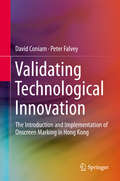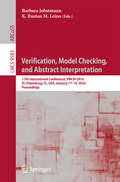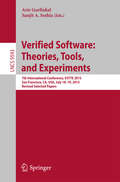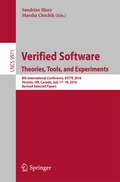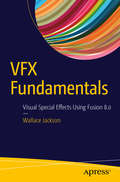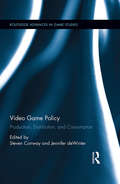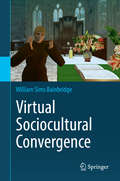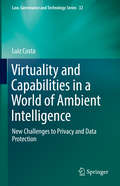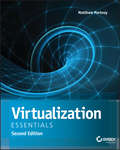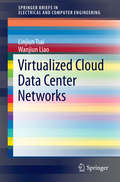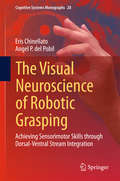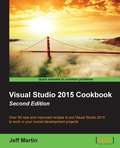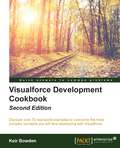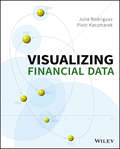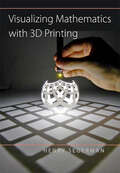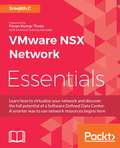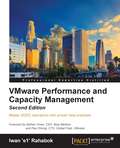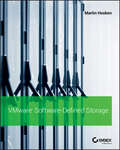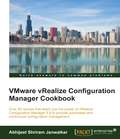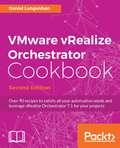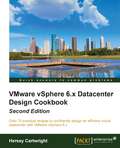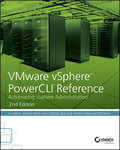- Table View
- List View
Validating Technological Innovation
by David Coniam Peter FalveyThis book discusses Hong Kong's use of onscreen marking (OSM) in public examinations. Given that Hong Kong leads the way in OSM innovation, this book has arisen from a recognised need to provide a comprehensive, coherent account of the findings of various separate but linked validation studies of onscreen public examinations in Hong Kong. The authors discuss their experience of the validation process, demonstrating how high-stakes innovation should be fully validated by a series of research studies in order to satisfy key stakeholders.
Verification, Model Checking, and Abstract Interpretation
by Barbara Jobstmann K. Rustan M. LeinoThis book constitutes the refereed proceedings of the 17th International Conference on Verification, Model Checking, and Abstract Interpretation, VMCAI 2016, held in St. Petersburg, FL, USA, in January 2016. The 24 full papers together with 2 invited talks and 1 abstract presented were carefully reviewed and selected from 67 submissions. VMCAI provides topics including: program verification, model checking, abstract interpretation and abstract domains, program synthesis, static analysis, type systems, deductive methods, program certification, debugging techniques, program transformation, optimization, hybrid and cyber-physical systems.
Verified Software: Theories, Tools, and Experiments
by Sanjit A. Seshia Arie GurfinkelThis volume constitutes the thoroughly refereed post-conference proceedings of the 7th International Conference on Verified Software: Theories, Tools and Experiments, VSTTE 2015, held in July 2015 in San Francisco, CA, USA. The 12 revised full papers presented were carefully revised and selected from 25 submissions. The goal of this conference is to advance the state of the art in the science and technology of software verification, through the interaction of theory development, tool evolution, and experimental validation and large-scale verification efforts that involve collaboration, theory unification, tool integration, and formalized domain knowledge.
Verified Software. Theories, Tools, and Experiments
by Sandrine Blazy Marsha ChechikThis volume constitutes the thoroughly refereed post-conference proceedings of the 8th International Conference on Verified Software: Theories, Tools and Experiments, VSTTE 2016, held in July 2016 in Toronto, ON, Canada. The 8 full papers together with 4 short papers and 5 invited papers presented were carefully revised and selected 21 submissions. The goal of the VSTTE conference is to advance the state of the art through the interaction of theory development, tool evolution, and experimental validation.
VFX Fundamentals
by Wallace JacksonThis book is a comprehensive, introductory title covering concepts central to Visual Special Effects using the free Black Magic Design Fusion 8. 0 software package. The book also provides foundational background information regarding concepts central to digital image compositing, digital video editing, digital illustration, digital painting, 3D, and digital audio in the first six chapters on new media theory, concepts and terminology. This book builds on the foundational concepts of digital image compositing, digital audio, digital video, digital illustration and digital painting. VFX Fundamentals will introduce more advanced VFX concepts and pipelines as the chapters progress, covering topics such as Flow Node Compositing, Timeline Animation, Animated PolyLine Masking, Bluescreen and Greenscreen Matte Pulling (generation), using Primatte and Fusion 8 Ultra Keyer, motion tracking, 3D rendering and compositing, auxiliary channels, and particle systems and particle physics dynamics, among other topics. What you'll learn The New Media Components (raster, vector, audio, video, rendering) needed for VFX The Concepts behind the Digital Visual Special Effects (VFX) Content Production Workflow How to Install and Utilize Black Magic Design Fusion 8 and it's Visual Programming Language Concepts behind Resolution, Aspect Ratio, Bit-Rate, Color Depth, Layers, Alpha, and Masking 2D VFX Concepts such as Animated Masking, Matte Pulling (Primatte V) and Motion Tracking 3D VFX Concepts such as 3D Geometry, Materials, Lighting, Animation and Auxiliary Channels Advanced VFX Concepts such as Particle Systems Animation using Real-World Physics (Forces) Who this book is for SFX artists, VFX artists, video editors, website developers, filmmakers, 2D and 3D animators, digital signage producers, e-learning content creators, game developers, multimedia producers.
Video Game Policy: Production, Distribution, and Consumption (Routledge Advances in Game Studies)
by Steven Conway and Jennifer deWinterThis book analyzes the effect of policy on the digital game complex: government, industry, corporations, distributors, players, and the like. Contributors argue that digital games are not created nor consumed outside of the complex power relationships that dictate the full production and distribution cycles, and that we need to consider those relationships in order to effectively "read" and analyze digital games. Through examining a selection of policies, e.g. the Australian government’s refusal (until recently) to allow an R18 rating for digital games, Blizzard’s policy in regards to intellectual property, Electronic Arts’ corporate policy for downloadable content (DLC), they show how policy, that is to say the rules governing the production, distribution and consumption of digital games, has a tangible effect upon our understanding of the digital game medium.
Virtual Competition
by Ariel EzrachiAriel Ezrachi and Maurice Stucke take a hard look at today's app-assisted paradise of digital shopping. The algorithms and data-crunching that make online purchasing so convenient are also changing the nature of the market by shifting power into the hands of the few, with risks to competition, our democratic ideals, and our overall well-being.
Virtual Sociocultural Convergence
by William Sims BainbridgeThis book explores the remarkable sociocultural convergencein multiplayer online games and other virtual worlds, through the unificationof computer science, social science, and the humanities. The emergence of online media provides notonly new methods for collecting social science data, but also contexts fordeveloping theory and conducting education in the arts as well astechnology. Notably, role-playing gamesand virtual worlds naturally demonstrate many classical concepts about human behaviour,in ways that encourage innovative thinking. The inspiration derives from the internationally shared values developedin a fifteen-year series of conferences on science and technology convergence. The primary methodology is focused on sending avatars, representingclassical social theorists or schools of thought, into online gameworlds thatharmonize with, or challenge, their fundamental ideas, including technologicaldeterminism, urban sociology, group formation, freedom versus control, classstratification, linguistic variation, functional equivalence across cultures, behaviouralpsychology, civilization collapse, and ethnic pluralism. Researchers and students in the social and behaviouralsciences will benefit from the many diverse examples of how both qualitativeand quantitative science of culture and society can be performed in onlinecommunities of many kinds, even as artists and gamers learn styles and skillsthey may apply in their own work and play.
Virtuality and Capabilities in a World of Ambient Intelligence
by Luiz CostaThis book is about power and freedoms in our technological world and has two main objectives. The first is to demonstrate that a theoretical exploration of the algorithmic governmentality hypothesis combined with the capability approach is useful for a better understanding of power and freedoms in Ambient Intelligence, a world where information and communication technologies are invisible, interconnected, context aware, personalized, adaptive to humans and act autonomously. The second is to argue that these theories are useful for a better comprehension of privacy and data protection concepts and the evolution of their regulation. Having these objectives in mind, the book outlines a number of theses based on two threads: first, the elimination of the social effects of uncertainty and the risks to freedoms and, second, the vindication of rights. Inspired by and building on the outcomes of different philosophical and legal approaches, this book embodies an effort to better understand the challenges posed by Ambient Intelligence technologies, opening paths for more effective realization of rights and rooting legal norms in the preservation of the potentiality of human capabilities.
Virtualization Essentials
by Matthew PortnoyLearn virtualization skills by building your own virtual machine Virtualization Essentials, Second Edition provides new and aspiring IT professionals with immersive training in working with virtualization environments. Clear, straightforward discussion simplifies complex concepts, and the hands-on tutorial approach helps you quickly get up to speed on the fundamentals. You'll begin by learning what virtualization is and how it works within the computing environment, then you'll dive right into building your own virtual machine. You'll learn how to set up the CPU, memory, storage, networking, and more as you master the skills that put you in-demand on the job market. Each chapter focuses on a specific goal, and concludes with review questions that test your understanding as well as suggested exercises that help you reinforce what you've learned. As more and more companies are leveraging virtualization, it's imperative that IT professionals have the skills and knowledge to interface with virtualization-centric infrastructures. This book takes a learning-by-doing approach to give you hands-on training and a core understanding of virtualization. Understand how virtualization works Create a virtual machine by scratch and migration Configure and manage basic components and supporting devices Develop the necessary skill set to work in today's virtual world Virtualization was initially used to build test labs, but its use has expanded to become best practice for a tremendous variety of IT solutions including high availability, business continuity, dynamic IT, and more. Cloud computing and DevOps rely on virtualization technologies, and the exponential spread of these and similar applications make virtualization proficiency a major value-add for any IT professional. Virtualization Essentials, Second Edition provides accessible, user-friendly, informative virtualization training for the forward-looking pro.
Virtualized Cloud Data Center Networks: Issues in Resource Management.
by Linjiun Tsai Wanjiun LiaoThis book discusses the characteristics of virtualized cloud networking, identifies the requirements of cloud network management, and illustrates the challenges in deploying virtual clusters in multi-tenant cloud data centers. The book also introduces network partitioning techniques to provide contention-free allocation, topology-invariant reallocation, and highly efficient resource utilization, based on the Fat-tree network structure. Managing cloud data center resources without considering resource contentions among different cloud services and dynamic resource demands adversely affects the performance of cloud services and reduces the resource utilization of cloud data centers. These challenges are mainly due to strict cluster topology requirements, resource contentions between uncooperative cloud services, and spatial/temporal data center resource fragmentation. Cloud data center network resource allocation/reallocation which cope well with such challenges will allow cloud services to be provisioned with predictable network performance, mitigate service performance degradation and even guarantee service level agreements. Virtualized Cloud Data Center Networks: Issues in Resource Management tackles the challenges of managing cloud data center networks and introduces techniques to efficiently deploy large-scale distributed computing applications that require predictable performance in multi-tenant cloud data centers.
Virtuous Policing: Bridging America's Gulf Between Police and Populace (500 Tips)
by David G. Bolgiano L. Morgan Banks III James M. Patterson"It pulls no punches, shuns no controversial topic, and glosses over no issues or problems that beset America‘s law enforcement community in our day. For those who may be prone to suspect the motives of these self-confessed lovers of cops and warriors, the title of this book‘should be sufficient to allay such concerns." John C. Hall, Supervisory Sp
The Visual Neuroscience of Robotic Grasping
by Eris Chinellato Angel P. PobilThis book presents interdisciplinary research that pursues the mutual enrichment of neuroscience and robotics. Building on experimental work, and on the wealth of literature regarding the two cortical pathways of visual processing - the dorsal and ventral streams - we define and implement, computationally and on a real robot, a functional model of the brain areas involved in vision-based grasping actions. Grasping in robotics is largely an unsolved problem, and we show how the bio-inspired approach is successful in dealing with some fundamental issues of the task. Our robotic system can safely perform grasping actions on different unmodeled objects, denoting especially reliable visual and visuomotor skills. The computational model and the robotic experiments help in validating theories on the mechanisms employed by the brain areas more directly involved in grasping actions. This book offers new insights and research hypotheses regarding such mechanisms, especially for what concerns the interaction between the dorsal and ventral streams. Moreover, it helps in establishing a common research framework for neuroscientists and roboticists regarding research on brain functions.
Visual Research Methods in Educational Research
by Julianne Moss Barbara PiniHave you noticed there is a burgeoning take up of visual research in education? Are you considering using visual research as part of your next research project or revitalising your research methods course? For researchers who are new to the field of VRMs in education there is little critical literature on the subject. This book addresses the gap in the literature and brings together some of the leading educational researchers engaging and reflecting on the visual from Australia, the UK and Canada. Encapsulated in a single volume, this book sets out theoretically grounded discussions of the possibilities and challenges of the approach for educational researchers around four key themes: images of schooling, performing pedagogy, power and representation and ethical issues in educational research.
Visual Studio 2015 Cookbook - Second Edition
by Jeff MartinOver 50 new and improved recipes to put Visual Studio 2015 to work in your crucial development projects About This Book * Get to grips with all the new Visual Studio 2015 features regardless of your preferred programming language * Apply Visual Studio to all areas of development: writing, debugging, and application lifecycle maintenance * Straightforward and hands-on advice for building both Windows and Android apps Who This Book Is For If you are a developer excited about the new features introduced in Visual Studio 2015, then no matter what your programming language of choice is, Visual Studio 2015 Cookbook is for you. You should have a good knowledge of working with previous versions of Visual Studio to benefit from the recipes in this book. What You Will Learn * Customize the editor's new abilities to fit your development style * Create apps for Windows * Use Visual Studio to debug parallel and concurrent programs * Integrate .NET Framework 4.6 effectively * Put TypeScript to work in your web applications * Develop modern C++11 with Visual Studio 2015 * Protect and manage your source code with Team Foundation Server In Detail Visual Studio 2015 is the premier tool for developers targeting the Microsoft platform. Learning how to effectively use this technology can enhance your productivity while simplifying your most common tasks, allowing you more time to focus on your project. Visual Studio 2015 is packed with improvements that increase productivity, and this book walks you through each one in succession to help you smooth your workflow and get more accomplished. From customization and the interface to code snippets and debugging, the Visual Studio upgrade expands your options -- and this book is your fast-track guide to getting on board quickly. Visual Studio 2015 Cookbook will introduce you to all the new areas of Visual Studio and how they can quickly be put to use to improve your everyday development tasks. With this book, you will learn not only what VS2015 offers, but what it takes to put it to work for your projects. Style and approach This book is a practical guide to using Visual Studio 2015 and will help you become familiar with the improvements made in previous versions. Each recipe provides a hands-on approach to the new features with step-by-step instructions on how to increase your productivity.
Visualforce Development Cookbook - Second Edition
by Keir BowdenDiscover over 70 real-world examples to overcome the most complex concepts you will face developing with Visualforce About This Book * This book provides an enhanced user experience with dynamically-generated, reactive pages * Access data over additional channels via public web sites and mobile pages * Packed with easy-to-follow recipes, including step-by-step instructions and Apex/Visualforce code downloads this title is the all in one package you need to get more from Visualforce. Who This Book Is For This book will be beneficial to developers who are already well-versed with the basics of Visualforce. An awareness of the standard component library and the purpose of controllers is expected. What You Will Learn * Pass parameters between Visualforce pages * Update attributes in component controllers * Avoid validation errors with action regions * Refresh record details from embedded Visualforce * Create and develop a website template from scratch * Get to know about the Salesforce Lightening Design system and use Visualforce in Salesforce1 * Effectively tackle frequently-faced problems while developing Visualforce pages In Detail Visualforce is a framework that allows developers to build sophisticated, custom user interfaces that can be hosted natively on the Force.com platform. The Visualforce framework includes a tag-based markup language, similar to HTML that is used to write the Visualforce pages and a set of controllers that are used to write business logic to the Visualforce pages. Visualforce Development Cookbook provides solutions to a variety of challenges faced by Salesforce developers and demonstrates how easy it is to build rich, interactive pages using Visualforce. Whether you are looking to make a minor addition to the standard page functionality or override it completely, this book will provide you with the help you require throughout. You will start by learning about the simple utilities and will build up to more advanced techniques for data visualization and to reuse functionality. You will learn how to perform various tasks such as creating multiple records from a single page, visualizing data as charts, using JavaScript to enhance client-side functionality, building a public website, and making data available to a mobile device. With an interesting chapter on tackling common issues faced while developing Visualforce pages, the book provides lots of practical examples to enhance and extend your Salesforce user interface. Style and approach Following a cookbook structure, the book provides recipes on some essential technical scenarios and a few that focus on real-world development problems. This book is packed with illustrations and contains lots of code samples to improve your understanding.
Visualizing Financial Data
by Piotr Kaczmarek Julie RodriguezA fresh take on financial data visualization for greater accuracy and understanding Visualizing Financial Data shows you how to design dynamic, best-of-breed visualizations for better communication of financial data. This book provides a comprehensive set of visualizations tailored to the most common requirements for corporate financial reporting, as well as portfolio, mutual fund, and hedge fund management. This highly visual, full color book showcases a series of cases that push data communication conventions forward, demonstrating and contrasting traditional bar, line, and pie charts against more modern visual methods. The companion website features all of the visualizations discussed, and provides the underlying datasets that you can use to practice on your own or customize the visualizations for your own use. Get a fresh take on visualizations and insight you need to communicate financial data better than ever before. Expand the boundaries of data visualization conventions Optimize data communications, understanding, and disclosure Learn new approaches to traditional charts and visualizations Create exemplary visualizations Visualizing Financial Data shows you newer, better ways of communicating the full meaning of the data, to support efficient, timely, and effective decision-making.
Visualizing Mathematics with 3D Printing
by Henry SegermanThe first book to explain mathematics using 3D printed models.Winner of the Technical Text of the Washington PublishersWouldn’t it be great to experience three-dimensional ideas in three dimensions? In this book—the first of its kind—mathematician and mathematical artist Henry Segerman takes readers on a fascinating tour of two-, three-, and four-dimensional mathematics, exploring Euclidean and non-Euclidean geometries, symmetry, knots, tilings, and soap films. Visualizing Mathematics with 3D Printing includes more than 100 color photographs of 3D printed models. Readers can take the book’s insights to a new level by visiting its sister website, 3dprintmath.com, which features virtual three-dimensional versions of the models for readers to explore. These models can also be ordered online or downloaded to print on a 3D printer. Combining the strengths of book and website, this volume pulls higher geometry and topology out of the realm of the abstract and puts it into the hands of anyone fascinated by mathematical relationships of shape. With the book in one hand and a 3D printed model in the other, readers can find deeper meaning while holding a hyperbolic honeycomb, touching the twists of a torus knot, or caressing the curves of a Klein quartic.
VMware NSX Network Essentials
by Sreejith. CLearn how to virtualize your network and discover the full potential of a Software Defined Data Center. A smarter way to use network resources begins here About This Book * Experience the dynamism and flexibility of a virtualized software defined data center with NSX * Find out how to design your network infrastructure based on what your organization needs * From security to automation, discover how NSX's impressive range of features can unlock a more effective and intelligent approach to system administration Who This Book Is For If you're a network administrator and want a simple but powerful solution to your network virtualization headaches, look no further than this fast-paced, practical guide. What You Will Learn * Deep dive into NSX-v Manager, Controller deployment, and design decisions * Get to know the strategies needed to make decisions on each mode of VXLAN that is based on physical network design * Deploy Edge Gateway and leverage all the gateway features and design decisions * Get to grips with NSX-v Security features and automate security * Leverage Cross VC, identify the benefits, and work through a few deployment scenarios * Troubleshoot an NSX-v to isolate problems and identify solutions through a step-by-step process In Detail VMware NSX is at the forefront of the software-defined networking revolution. It makes it even easier for organizations to unlock the full benefits of a software-defined data center - scalability, flexibility - while adding in vital security and automation features to keep any sysadmin happy. Software alone won't power your business - with NSX you can use it more effectively than ever before, optimizing your resources and reducing costs. Getting started should be easy - this guide makes sure it is. It takes you through the core components of NSX, demonstrating how to set it up, customize it within your current network architecture. You'll learn the principles of effective design, as well as some things you may need to take into consideration when you're creating your virtual networks. We'll also show you how to construct and maintain virtual networks, and how to deal with any tricky situations and failures. By the end, you'll be confident you can deliver, scale and secure an exemplary virtualized network with NSX. Style and approach This book provides you with an introduction to software-defined networking with VMware NSX. Focusing on the most essential elements, so you can put your knowledge into practice quickly, it's a guide dedicated to anyone who understands that sometimes real-world problems require virtualized solutions.
VMware Performance and Capacity Management - Second Edition
by Iwan 'E1' RahabokMaster SDDC Operations with proven best practices About This Book * Understand the drawbacks of the traditional paradigm and management that make operations difficult in SDDC * Master performance and capacity management in Software-Defined Data Center * Operationalize performance and capacity monitoring with proven dashboards Who This Book Is For This book is primarily for any system administrator or cloud infrastructure specialist who is interested in performance management and capacity management using VMware technologies. This book will also help IT professionals whose area of responsibility is not VMware, but who work with the VMware team. You can be Windows, Linux, Storage, or Network team; or application architects. Note that prior exposure to the VMware platform of data-center and cloud-based solutions is expected. What You Will Learn * Simplify the task of performance and capacity management * Master the counters in vCenter and vRealize Operations and understand their dependency on one another * Educate your peers and management on SDDC Operations * Complete your SDDC monitoring to include non-VMware components * Perform SDDC performance troubleshooting * Explore real-life examples of how super metric and advanced dashboards * Introduce and implement a Performance SLA * Accomplish your Capacity Management by taking into service tiering and performance SLA In Detail Performance management and capacity management are the two top-most issues faced by enterprise IT when doing virtualization. Until the first edition of the book, there was no in-depth coverage on the topic to tackle the issues systematically. The second edition expands the first edition, with added information and reorganizing the book into three logical parts. The first part provides the technical foundation of SDDC Management. It explains the difference between a software-defined data center and a classic physical data center, and how it impacts both architecture and operations. From this strategic view, it zooms into the most common challenges--performance management and capacity management. It introduces a new concept called Performance SLA and also a new way of doing capacity management. The next part provides the actual solution that you can implement in your environment. It puts the theories together and provides real-life examples created together with customers. It provides the reasons behind each dashboard, so that you get the understanding on why it is required and what problem it solves. The last part acts as a reference section. It provides a complete reference to vSphere and vRealize Operations counters, explaining their dependencies and providing practical guidance on the values you should expect in a healthy environment. Style and approach This book covers the complex topic of managing performance and capacity in an easy-to-follow style. It relates real-world scenarios to topics in order to help you implement the book's teachings on the go.
VMware Software-Defined Storage: A Design Guide to the Policy-Driven, Software-Defined Storage Era
by Martin HoskenThe inside guide to the next generation of data storage technology VMware Software-Defined Storage, A Guide to the Policy Driven, Software-Defined Storage Era presents the most in-depth look at VMware's next-generation storage technology to help solutions architects and operational teams maximize quality storage design. Written by a double VMware Certified Design Expert, this book delves into the design factors and capabilities of Virtual SAN and Virtual Volumes to provide a uniquely detailed examination of the software-defined storage model. Storage-as-a-Service (STaaS) is discussed in terms of deployment through VMware technology, with insight into the provisioning of storage resources and operational management, while legacy storage and storage protocol concepts provide context and demonstrate how Virtual SAN and Virtual Volumes are meeting traditional challenges. The discussion on architecture emphasizes the economies of storage alongside specific design factors for next-generation VMware based storage solutions, and is followed by an example in which a solution is created based on the preferred option identified from a selection of cross-site design options. Storage hardware lifecycle management is an ongoing challenge for IT organizations and service providers. VMware is addressing these challenges through the software-defined storage model and Virtual SAN and Virtual Volumes technologies; this book provides unprecedented detail and expert guidance on the future of storage. Understand the architectural design factors of VMware-based storage Learn best practices for Virtual SAN stretched architecture implementation Deploy STaaS through vRealize Automation and vRealize Orchestrator Meet traditional storage challenges with next-generation storage technology Virtual SAN and Virtual Volumes are leading the way in efficiency, automation, and simplification, while maintaining enterprise-class features and performance. As organizations around the world are looking to cut costs without sacrificing performance, availability, or scalability, VMware-based next-generation storage solutions are the ideal platform for tomorrow's virtual infrastructure. VMware Software-Defined Storage provides detailed, practical guidance on the model that is set to transform all aspects of vSphere data center storage.
VMware vRealize Configuration Manager Cookbook
by Abhijeet Shriram JanwalkarOver 80 recipes to teach you the power of vRealize Configuration Manager 5.8 to provide automated and continuous configuration management About This Book * First book in the market that provides a broad configuration and compliance management solution for your enterprise. * Champion the skills of the latest features of VMware vRealize Configuration Manager and implement it in your organization. * A recipe based approach book that will enlighten you to configure VCM to collect and manage data from your virtual and physical environment. Who This Book Is For If you are a system administrator who is eager to provide better administration with VCM and are familiar with managing network users and resources along with performing system maintenance, then this book is for you. What You Will Learn * Find out how to configure automated patching of your infrastructure for Windows as well Unix machines * Maintain and upgrade your vRealize Configuration Manager * Integrate with other VMware tools such as vCloud Director, vRealise Operations, vCenter, and vCloud Network and Security * Understand what vRealize Configuration Manager is and what its capacities are * Explore how vRealize Configuration Manager can be used for patching, compliance management, and software distribution * Troubleshoot vRealize Configuration Manager with ease In Detail VMware vRealize Configuration Manager (VCM) helps you to automate IT operations, manage performance, and gain visibility across physical and virtual infrastructure. It is continuously being used by enterprises to audit the configurations of the VMware infrastructure as well as the Windows, Linux, and UNIX operating systems. This book is filled with practical recipes through which you will learn about the latest features of vRealize Configuration Manager 5.8.X, starting with installation of various tiers of VCM followed by configuration management across physical and virtual servers. Throughout this book, you will explore how VCM can perform tasks such as patch management, compliance assessment, and software package distribution along with Machine filters for new platforms such as RHEL 7 and Windows 10. This book will ease your troubles while upgrading from the existing VCM to the latest version by providing you with step-by-step instructions about the process of migration along with upgrade and maintenance support. This book will help you understand how to integrate vRealize Configuration with other applications along with schedule management and also guide you on how to handle security issues. After reading this book, you will have a clear understanding of how VCM fits in the overall picture of the data center design from a patching and compliance perspective. Style and approach This book takes a recipe-based approach that will provide you with an effective and a practical configuration management solution for your enterprise.
VMware vRealize Orchestrator Cookbook - Second Edition
by Daniel LangenhanOver 90 recipes to satisfy all your automation needs and leverage vRealize Orchestrator 7.1 for your projects About This Book * Unleash the power of VMware vRealize Orchestrator 7 and automate your VMware infrastructure * Customize and tune your orchestrator by programming and working with plugins * Work through enticing recipes that can be implemented in your organization * Explore the new and upcoming plugins of Puppet, Docker, Chef, and VMware Replication for VMware vRealize Orchestrator Who This Book Is For This book is for system administrators who are into VMware administration and are looking to automate their infrastructure. Basic knowledge about programming is needed. No previous knowledge of Orchestrator is required. This book will also be good for you if you have just a basic knowledge with vRealize Orchestrator, as you can pick up any recipe and implement it for your enterprise. What You Will Learn * Install, configure, and optimize Orchestrator installations (Windows, Appliance, and vRA integrated) * Explore all the visual programming elements without needing additional infrastructure * Work with plugins such as SSH, mail, SQL, PowerShell, AD, SOAP, SNMP, AMQP, and REST * Discover how to create VMware automation * Get to know about user management, import/export, and synchronization as well as the packaging application * Understand policies, resources, and web views * Troubleshoot vRO Appliance In Detail VMware vRealize Orchestrator is a powerful automation tool designed for system administrators and IT operations staff who are planning to streamline their tasks and are waiting to integrate the functions with third-party operations software. This book is an update to VMware vRealize Orchestrator Cookbook and is blend of numerous recipes on vRealize Orchestrator 7. This book starts with installing and configuring vRealize Orchestrator. We will demonstrate how to upgrade from previous versions to vRealize Orchestrator 7. You will be taught all about orchestrator plugins and how to use and develop various plugins that have been enhanced in Orchestrator 7. Throughout this book, you will explore the new features of Orchestrator 7, such as the introduction of the control center, along with its uses. You will also come to understand visual programming, how to integrate base plugins into workflows, and how to automate VMware. You will also get to know how to troubleshoot vRealize Orchestrator. By the end of this book, you will be able to get the most out of your Orchestrator installation, and will be able to develop complex workflows and create your own highly integrated automations of vRealize environments. Style and approach This practical guide provides exciting and practical recipes on VMware vRealize Orchestrator 7 for those who are waiting to automate their infrastructure.
VMware vSphere 6.X Datacenter Design Cookbook - Second Edition
by Hersey CartwrightIf you are an administrator or consultant interested in designing virtualized datacenter environments using VMware vSphere 6.x or previous versions of vSphere and the supporting components, this book is for you. It will help both new and experienced architects deliver professional VMware vSphere virtual datacenter designs.
VMware vSphere PowerCLI Reference
by Andrew Sullivan Glenn Sizemore Luc Dekens Jonathan Medd Brian Graf Matt BorenMaster vSphere automation with this comprehensive reference VMware vSphere PowerCLI Reference, Automating vSphere Administration, 2nd Edition is a one-stop solution for vSphere automation. Fully updated to align with the latest vSphere and PowerCLI release, this detailed guide shows you how to get the most out of PowerCLI's handy cmdlets using real-world examples and a practical, task-based approach. You'll learn how to store, access, update, back up, and secure massive amounts of data quickly through the power of virtualization automation, and you'll get acquainted with PowerCLI as you learn how to automate management, monitoring, and life-cycle operations for vSphere. Coverage includes areas like the PowerCLI SDK, SRM, vCOPS, and vCloud Air. Plus guidance toward scheduling and viewing automation, using DevOps methodology and structured testing and source control of your PowerCLI scripts. Clear language and detailed explanations make this reference the manual you've been looking for. This book is your complete reference for managing vSphere in a Windows environment, with expert instruction and real-world application. Automate vCenter Server deployment and configuration Create and configure virtual machines, and utilize vApps Monitor, audit, and report the status of your vSphere environment Secure, back up, and restore your virtual machines Work with other vSphere components from your PowerCLI scripts Take control of your PowerCLI scripts through versioning and structured testing Don't spend another day slogging through routine systems management -- automate it, with this invaluable guide.
